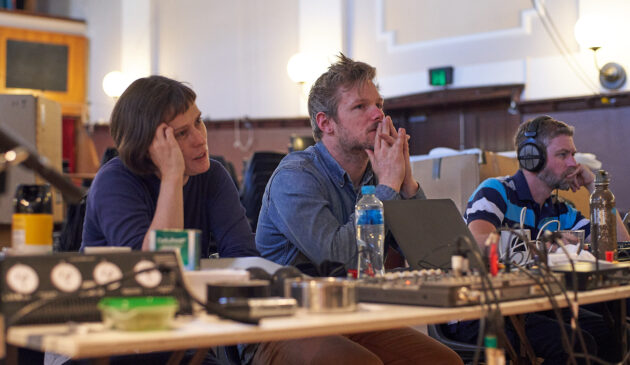
We sat down with Alison Currie and Alisdair Macindoe from Progress Report to talk about the work.
Tell us about Progress Report. Where did the idea come from, and what are you hoping that people get out of the work?
Alisdair: Progress Report is a theatrical response to the inner turmoil and cognitive dissonance brought on by considering the climate crisis and envisioning a future. The projects roots however were seeded by a far more abstract interest in the physical qualities of Polystyrene. Alison happened upon a really interesting choreographic scenario years ago while developing another work that involved standing in front of a fan and dancing with a large sheet of polystyrene.
Alison: We liked the idea and when we thought about working together years later we re-started with the foam and the fan. The idea developed from there, with the styrofoam material unpacking (pardon the pun) concerns about plastic, waste, and consumption.
Alisdair: The work is this simultaneous celebration of the physical beauty of a man made material and a reflection on its devastating impact on our planet and lives.
Alison: We’re hoping that people will be intrigued, amused, and made uncomfortable by the work and see their own experiences of dilemma reflected back to them. We hope that people will be taken on a ride and leave reflecting on the world we live in.
It started life as an Adhocracy project. Has it changed much since then? Where did you think the work would end up?
Alison: Adhocracy was such a fantastic way to kick start the project! We achieved so much in just four days! Lewis Rankin was working with us on that development, he has moved on to doing amazing things with Gravity and Other Myths. We have had a few team changes since but in essence, the project is the same, a solo performance with objects and since that first development we have become more and more focussed on human impact and experience on this world.
Alisdair: The Adhocracy development answered the question we had in regards to viability, as one of the biggest gaps when imagining a work is whether that work would actually be of any interest when fully realised. What we did is plot out the ark of the entire show in a very rough way and found that we had the bones for what could be a really interesting and engaging piece, were we to invest more time in refinement. So the essential identifiers of the work have been there right from the start, and a lot of the development time has been spent translating rough sketches into fully realised and detailed ideas. We knew by the end of the Adhocracy development that we would do what ever it took to develop and present the work, we knew the kind of performance environment it was suited to, what we didn’t know was whether we could garnish interest from presenters and whether the idea would be as interesting to said presenters as it was to us.
How did the two of you start working together? Is this your first project?
Alison: Our first show together was in 2008 Alisdair made interactive and site specific sound installations for my work ’42a’, since then we have collaborated on various projects including ‘I Can Relate’ commissioned by Carriageworks 2015 and ‘Concrete Impermanence’ 2018, again with Alisdair predominately making sound, but also joining the conversations about the works structure and assisting in the creation of the work in general. We have discussed our other projects with each other over the years and have a great respect for each others work, which has made it easy to trust each other when taking on the role as shared lead artists for this project. Progress Report is the first time we have worked as co-directors. Its very rewarding, exciting and fun!!
You’re both clearly passionate about recycling. The set is made from recycled plastics including a lot of styrofoam. What’s it like working and dancing with unexpected materials?
Alison: The styrofoam does break into small pieces that we are careful to vacuum up at the end of each rehearsal day. so there is a microcosm reflective of global issues happening in the studio. The restriction of using select materials means that we are pushed to invent different ways of using these same objects, and how to represent them in different situations.
Alisdair: The styrofoam, just like the dancing body, is a site of potential creatively speaking, it can be cut and change form with ease, especially so, given we are working with industrial sized pieces, and so working with it has been expansive and exploratory. It is a fascinating material with really unique properties that prompt really interesting choreographic scenarios.
Any final words?
Alisdair: Through Progress Report we are responding to climate change as a human problem, where human drivers and motives are wrapped up in social norms, convoluted and distorted by social histories and deeply embedded behaviour patterns. It’s like the work is a cornered beast trying to find its way out of an impending doom, it is trying to cry out for help by envisioning preposterous and impossible alternate realities as a way to psychologically accept reality. Coming to terms with reality is kind of presented as a madness in this work, as it may well be, given how much as humans we love and accept story, fantasy and ambition as cultural guides.



